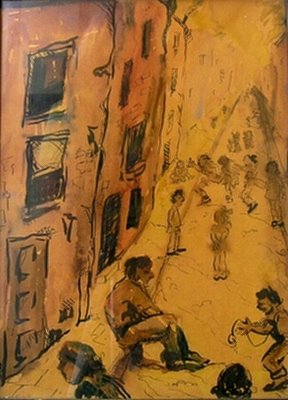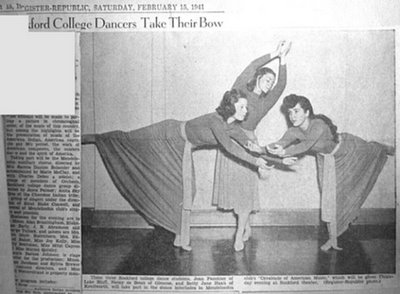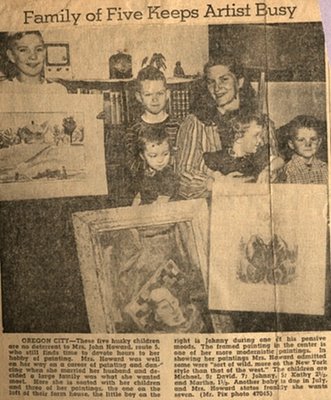Chapter 1: Mom the artist, 1928-1952
Mom was born Nancy Millicent deBeers on March 6, 1919, in Evanston, Illinois. Her father was a chemical engineer and industrialist who by Mom’s birth had already made his fortune and was on the brink of retirement. They lived in the fashionable North Shore suburb of Glencoe close to Lake Michigan, on a tree-lined street of stately homes. Her mother had studied art at the Chicago Academy of Fine Arts and enjoyed some popularity as a painter of children’s portraits in the professional milieu in which they lived. She saved one newspaper clipping of her mother's (1a)

It was only natural that Nancy would follow in her mother’s footsteps. Her proud parents were quick to appreciate her talents. I remember a small framed drawing in my grandparents’ apartment shortly after they moved from Chicago to Rose Villa, a retirement center near Oregon City, the town where their daughter had moved 35 years earlier. My grandmother said, “Your mother did that when she was nine years old.” The sketch (1b) shows children playing on an inner city street, which Mom later told me was a Jewish tenement district on the South Side of Chicago.

Perhaps Mom had accompanied her dad there as he attended to his business and had been fascinated by the children playing in the street, such a different environment from her own broad lawns and set-back homes. The style is very much that of sketches she did 50 or 60 years later. I am in awe of Mom’s powers of observation. But when I see photos of her at that age I guess I am not surprised (1c).

Art lessons were part of Mom’s young life. I didn’t discover another early painting until shortly before she died, when I saw one that said on the back “Nancy deBeers, artist” and “age 13,” along with the names of its owner, Florence and Franklin de Beers (1d). I am not sure who wrote these words, and I am surprised neither Mom nor her mother ever mentioned it. The style is so different from anything else she did. One might wonder whether the words on the back are accurate, and whether it is really hers. But I see no reason not to trust these words. Perhaps she was just doing what she was taught, trying out a realist style that did not fit her personal temperament.

At Rockford College, then a private women’s college, Mom continued taking art classes, although her major subjects were dance and anthropology. The caption to the newspaper photo (1e)says that the the three students were dancing to Mendelssohn’s music for Midsummer Night’s Dream. Mom would be the dancer in the middle:

Among the artworks Mom left behind is a sketch with the title “Midsummer Night’s Dream, Act III, Scene I, Titania” (1f). It was likely done in the 1980’s or 90’s. It goes to show how connected her art was with her dance.

After graduation Mom attended a dance summer school at Mills College, under the direction of Merce Cunningham and composer John Cage. Then she studied painting at the Art Students’ League in New York City. Her teachers included some of the great artists of Europe, refugees from the tumult there. Her favorite teacher, she told me, was Raphael Soyer, a Russian-Jewish emigre. Certainly the portraits she did later show his influence. At the League she met her first husband Richard Anderson, whom she described as a poet. The Anderson family saved a few of his poems, and they are good ones. Possibly his income came from modeling.
After a couple of years Mom and Richard divorced. He apparently could not adapt to settling down and raising a family. She had a brief stint teaching dance, in Chicago with the Sybil Shearer Dance Group, where she also did choreography, and in the art colony town of Saugatuck, Michigan. I remember waiting at the Episcopal Church after nursery school for Mom to finish her class. Then she married John Howard, a native Oregonian who met my mother while sight-seeing back East. One of them had placed a personals ad and the other responded. One of the first things she did when we moved into our new home—where Mom would stay for 38 years—was to paint an exotic train scene on the closet door to the boys’ bedroom (1h):

When my brother David was back for Mom's memorial service, he discovered another piece she did and e-mailed a photo (1i). To this day there hangs in Park Place School, where we kids attended grades 1-6, a drawing she did of the original wood building, which was torn down in 1948 and replaced with the current brick structure.

We never found her other work from the 1940’s. She kept it in the attic, but when we helped her move in 2005 we could find nothing. The piece that had made the biggest impression on us kids, playing in the attic when our parents weren’t around, was one with a skull and chessboard, suggesting the vagaries of fortune in the face of careful planning. The only evidence we have of it now is a newspaper clipping she kept, from around 1952 (1j):

There it is, in the center of the photo. The painting on the left shows how the farm looked then, with a dirt road downhill from the house leading to our barn. Old maps, she told us, showed a road there, connecting what is now a dead end road, ending with us, to Forsythe Road below us. So what was for us the back of the house was originally the front, she said. The painting on the right is of a child, probably Johnny.
After that, for 20 years, Mom sketched mainly on our summer vacations. Her creative energy went mostly into raising nine children and writing, both a newspaper column, “Nancy’s Notions,” and children’s stories, one of which became the book Three Billies Go to Town, published by Parents’ Magazine Press. The illustrations for these stories were done by the magazines’ own illustrators. They probably didn’t even know of Mom’s other talents.

It was only natural that Nancy would follow in her mother’s footsteps. Her proud parents were quick to appreciate her talents. I remember a small framed drawing in my grandparents’ apartment shortly after they moved from Chicago to Rose Villa, a retirement center near Oregon City, the town where their daughter had moved 35 years earlier. My grandmother said, “Your mother did that when she was nine years old.” The sketch (1b) shows children playing on an inner city street, which Mom later told me was a Jewish tenement district on the South Side of Chicago.

Perhaps Mom had accompanied her dad there as he attended to his business and had been fascinated by the children playing in the street, such a different environment from her own broad lawns and set-back homes. The style is very much that of sketches she did 50 or 60 years later. I am in awe of Mom’s powers of observation. But when I see photos of her at that age I guess I am not surprised (1c).

Art lessons were part of Mom’s young life. I didn’t discover another early painting until shortly before she died, when I saw one that said on the back “Nancy deBeers, artist” and “age 13,” along with the names of its owner, Florence and Franklin de Beers (1d). I am not sure who wrote these words, and I am surprised neither Mom nor her mother ever mentioned it. The style is so different from anything else she did. One might wonder whether the words on the back are accurate, and whether it is really hers. But I see no reason not to trust these words. Perhaps she was just doing what she was taught, trying out a realist style that did not fit her personal temperament.

At Rockford College, then a private women’s college, Mom continued taking art classes, although her major subjects were dance and anthropology. The caption to the newspaper photo (1e)says that the the three students were dancing to Mendelssohn’s music for Midsummer Night’s Dream. Mom would be the dancer in the middle:

Among the artworks Mom left behind is a sketch with the title “Midsummer Night’s Dream, Act III, Scene I, Titania” (1f). It was likely done in the 1980’s or 90’s. It goes to show how connected her art was with her dance.

After graduation Mom attended a dance summer school at Mills College, under the direction of Merce Cunningham and composer John Cage. Then she studied painting at the Art Students’ League in New York City. Her teachers included some of the great artists of Europe, refugees from the tumult there. Her favorite teacher, she told me, was Raphael Soyer, a Russian-Jewish emigre. Certainly the portraits she did later show his influence. At the League she met her first husband Richard Anderson, whom she described as a poet. The Anderson family saved a few of his poems, and they are good ones. Possibly his income came from modeling.
After a couple of years Mom and Richard divorced. He apparently could not adapt to settling down and raising a family. She had a brief stint teaching dance, in Chicago with the Sybil Shearer Dance Group, where she also did choreography, and in the art colony town of Saugatuck, Michigan. I remember waiting at the Episcopal Church after nursery school for Mom to finish her class. Then she married John Howard, a native Oregonian who met my mother while sight-seeing back East. One of them had placed a personals ad and the other responded. One of the first things she did when we moved into our new home—where Mom would stay for 38 years—was to paint an exotic train scene on the closet door to the boys’ bedroom (1h):

When my brother David was back for Mom's memorial service, he discovered another piece she did and e-mailed a photo (1i). To this day there hangs in Park Place School, where we kids attended grades 1-6, a drawing she did of the original wood building, which was torn down in 1948 and replaced with the current brick structure.

We never found her other work from the 1940’s. She kept it in the attic, but when we helped her move in 2005 we could find nothing. The piece that had made the biggest impression on us kids, playing in the attic when our parents weren’t around, was one with a skull and chessboard, suggesting the vagaries of fortune in the face of careful planning. The only evidence we have of it now is a newspaper clipping she kept, from around 1952 (1j):

There it is, in the center of the photo. The painting on the left shows how the farm looked then, with a dirt road downhill from the house leading to our barn. Old maps, she told us, showed a road there, connecting what is now a dead end road, ending with us, to Forsythe Road below us. So what was for us the back of the house was originally the front, she said. The painting on the right is of a child, probably Johnny.
After that, for 20 years, Mom sketched mainly on our summer vacations. Her creative energy went mostly into raising nine children and writing, both a newspaper column, “Nancy’s Notions,” and children’s stories, one of which became the book Three Billies Go to Town, published by Parents’ Magazine Press. The illustrations for these stories were done by the magazines’ own illustrators. They probably didn’t even know of Mom’s other talents.

1 Comments:
Michael, you have done an extraordinary labor of love in presenting your mother's life and her paintings and drawings. What a magnificent woman. All this and while raising almost single-handedly nine children.
Jenika
Post a Comment
<< Home